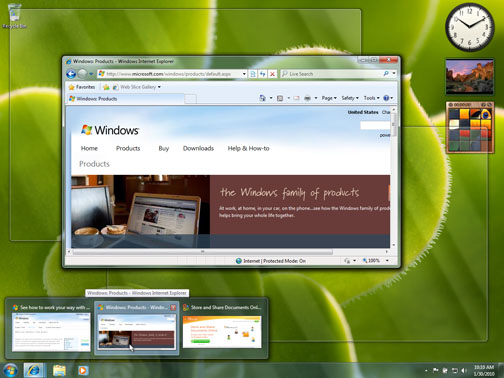On 22 October, the world will wake up to the arrival of a new operating system (OS) from Microsoft, Windows 7. Around 90pc of the world’s computer manufacturers will release their first machines with the new OS.
I tend to regard the arrival of each new Windows OS as era-defining, from Bill Gates showing off Windows 95 to a packed RDS just ahead of our boom economy to Windows XP arriving when computing became more broadly engrained in work and life.
Windows Vista, probably the most reviled of the family, demanded vast system requirements and was clunky to use. Curiously, its 2006 debut coincided with a time when economies and property markets were becoming bloated. Many computer users who matured on XP preferred the previous OS, believing Vista to be overly complex and slow.
When I talk to Microsoft folk, they are usually surprised at the harsh criticisms Vista receives, believing it to be a technologically superior beast.
Wooing back end users
Windows 7 is Microsoft’s effort to win back the end users, returning to the simplicity of XP and keeping the technical stuff under the bonnet. A source at Microsoft concurs: “Windows 7 is Vista with next-generation technology bolted on. It is effectively taking the best stuff of Vista and XP, making changes in the basic code and taking users to the next level in terms of user interface.”
The best way to sum up Windows 7 is to think of it as a fitness make-over. They took Vista to the gym and now it is more toned.
The first thing I noticed about the new OS was how tidy everything appeared. The ribbon on the bottom of the machine can be used to bring you swiftly to your most-used applications – in my case Microsoft Word and Internet Explorer 8. Here’s where the usefulness of the new OS presented itself: in the past, documents you would have opened appeared in a linear fashion; with Windows 7, tiny images of the documents appear across the screen and with a flick of your wrist you can toggle between the documents on a pane. Brilliant if you’re working on several projects at once.
This feature was especially useful when it came to internet surfing. These days, most internet surfers work off numerous pages at once, whether it’s reading news, email or Facebook to downloading a YouTube video or tweeting mates on Twitter.

Built for speed
The second thing that occurred to me – and it should have been first – was the speed of the OS. Connectivity – vital in a world where more computing takes place online than offline – is a lot more easily managed and I could go online via Wi-Fi or 3G broadband without having to mess with network settings. Just turn on and play.
My favourite feature in the new OS is Windows Live. This allows you to take whatever you are doing on a computer and share it wherever you wish online. For example, with Windows Live Photo Gallery I was able to suck images off my digital camera in seconds and then by tapping on the ‘Publish’ bar post them on Facebook instantly.
The Aero interface that debuted with Vista comes into its own on the new OS, and a little button on the right-hand side allows you to hide everything and remove clutter from the desktop.
Groups creation
Windows 7 also comes with the ability to create home groups – private local area networks for your household. Most broadband-connected homes today have Wi-Fi and up to three laptops and an Xbox. By creating a home group, you can connect up all the devices, set up a password and do things such as transmit photos between computers or put them onto your Xbox 360.
One of the things that the slimmed-down new OS Windows 7 is really meant to do is not only signal faster running next-generation PCs and netbooks, but also to breathe life into older machines and help them run better. A Microsoft spokesman told me that there’s a competition under way to see if they can run Windows 7 on the oldest, most limited machines possible.
Putting this to the test, I elected to put the Windows 7 release candidate on my fiancée’s troublesome Vista-based Advent laptop that, despite being three years old, drives like a rusty Morris Minor. Installation took me about an hour and a half.
Once the new OS was up and running, Wi-Fi connectivity seemed more stable and switching between programmes was quick and easy.
Economic challenge
Windows 7 is being released in a tougher economic time than any previous OS Microsoft has ever been released and budgets will be tighter. Most analysts are predicting only modest sales of the OS in its first few months, but I believe the new OS could be the most important system Microsoft has yet delivered and possibly the most powerful in a world where the difference between offline and online will cease to be discernible.
The new OS will come preinstalled in new laptops after 22 October. To upgrade existing machines, it comes in three flavours: Windows 7 Home Premium (€119.99); Windows 7 Professional (€285); Windows 7 Ultimate (€299); and Full Home Premium (€199.99).
By John Kennedy
Photos: A Windows 7 desktop (topmost photo); and a peek at the taskbars in Windows 7.
Don’t miss Seven Cool Things About Windows 7 and learn how Windows 7 Ushers in a new era of Security and Reliability.